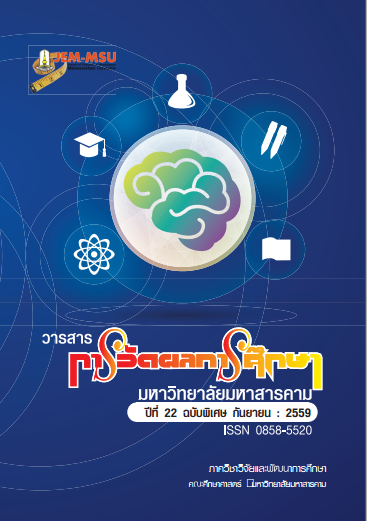Factors Relation to Effectiveness of the Educational Schools under The Secondary Educational Service Area office 26
Main Article Content
Abstract
This study attempted to find out the components of administrative effectiveness
of the schools and Factors relation to Effectiveness that influence administrative effectiveness
of the schools under the Secondary Educational Service Area Office 26.The samples,
selected by the purposive sampling technique, consisted of 34 educational administrators,
136 unit heads, 272 heads of eight departments, along with 308 teachers from the eight
departments chosen by the stratified random sampling technique. The research tools was a
questionnaire on the topic of Factors relation that Affect Administrative Effectiveness of
the schools. The factors influencing administrative effectiveness of the schools reliability
which constituted 97. Administrative effectiveness of the schools the reliability which
constituted 92. The statistics used were Pearson Product Moment Correlation, Exploratory
Factor Analysis, and Multiple Regression Analysis.
It was found that :
1. The administration in the schools under the Secondary Educational Service
Area Office 26 From the rotation axis of the 43 variables were found to be 8, but due to
the elements with 8 variables than 3 items had to cut it out because it is considered a
component composition is unclear. Made clear element 7 element 41 is variable consisted
of 7 components which covered 41 factors. Component 1 was Budget which comprised 8
factors. Component 2 dealt with Policy and Action which covered 8 factors. Component 3
was Leadership which comprised 6 factors. Component 4 was Information Technology which
consisted of 5 factors. Component 5 was Community Participation which covered 6 factors.
Component 6 was Atmosphere in the schools which covered 5 factors, and Component 7
was Parent Participation which comprised 3 factors. Factor loading was between 0.535-0.857.
All the components could describe the administrative management of the schools, which
constituted 71.947%. Administrative effectiveness of the schools under the Secondary
Educational Service Area Office 26 was found to be at a highest level. Policy and Action
was the only factor rated at a highest level. The other factors were rated at a high level,
which were ranged from high to low scores as follows: Budget, Parent Participation,
Leadership with an average score equaled to Community Participation, Atmosphere in an
Educational Institution, and Information and Technology, respectively. Those predictors had
a positive relation with administrative effectiveness of the schools under the Secondary
Educational Service Area Office 26, at the level of .01.
2. The predictors of administrative effectiveness of the schools under the
Secondary Educational Service Area Office 26 comprised Policy and Action, Leadership,
Parent Participation, and Atmosphere in the schools. The coefficients were presented in
the raw scores of .500, .193, .085, .069, and .084, respectively, and in the standard scores of
.538, .174, .086, .084, and .081, statistically significant at the .01 level. Prediction ability was
69.60%, standard error of .265, and
Prediction equation in raw scores
Y ′ = .362 + .500 X5 + .193 X3 + .085 X1 + .069 X6 + .084 X2
Prediction equation in standard scores
Z′Y = .538 ZX5 + .174 ZX3 + .086 ZX1 + .084 ZX6 + .081 ZX2
In conclusion, certain factors which could predict administrative effectiveness of
the schools under the Secondary Educational Service Area Office 26 consisted of Policy
and Action, Leadership, Parent Participation, and Atmosphere in the school. Therefore,
educational administrators should enhance and improve these factors to increase their
administrative effectiveness.
Article Details
The content and information contained in the published article in the Journal of Educational Measurement Mahasarakham University represent the opinions and responsibilities of the authors directly. The editorial board of the journal is not necessarily in agreement with or responsible for any of the content.
The articles, data, content, images, etc. that have been published in the Journal of Educational Measurement Mahasarakham University are copyrighted by the journal. If any individual or organization wishes to reproduce or perform any actions involving the entirety or any part of the content, they must obtain written permission from the Journal of Educational Measurement Mahasarakham University.

